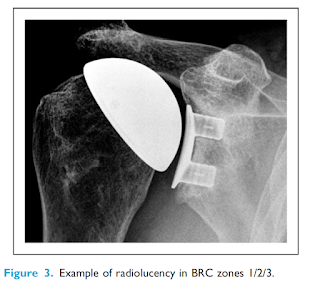Medium-term rates of radiolucency after primary total shoulder arthroplasty using a cementless metal-backed pegged polyethylene glenoid
These authors investigated periprosthetic radiolucency rates associated with an uncemented,metal-backed polyethylene glenoid component with medium-term results.
Methods: A single centre retrospective study examining radiological outcomes of the Epoca metal-backed glenoid component
Six patients had radiolucency on follow-up radiographs.
Comment: The high failure rate of metal backed glenoids from polyethylene failure has been previously described. See the additional references below:
To review, the abstract is reproduced here
BACKGROUND: Glenoid component failure is a common and serious complication of total shoulder arthroplasty. The purpose of this study was to evaluate published evidence on whether metal backing lessens the rate of glenoid component failure.
BACKGROUND: Glenoid component failure is a common and serious complication of total shoulder arthroplasty. The purpose of this study was to evaluate published evidence on whether metal backing lessens the rate of glenoid component failure.
METHODS: A comprehensive systematic review yielded twenty-one studies on radiolucency, radiographic failure, and revision after arthroplasty with metal-backed glenoid components and twenty-three studies with all-polyethylene components. Our analysis included data on 1571 metal-backed and 3035 all-polyethylene components. The mean duration of follow-up was 5.8 years in the studies with metal-backed components and 7.3 years with all-polyethylene components.
RESULTS: All-polyethylene components had a 42.5% rate of radiolucency compared with 34.9% for metal-backed components (p = 0.0026) and a 21.1% rate of radiographic loosening or failure compared with 16.8% for metal-backed components (p = 0.0005). However, the rate of revision was more than three times higher with metal-backed components (14.0%) than with all-polyethylene components (3.8%, p < 0.0001). Although 77% of the revisions of all-polyethylene components were for loosening, 62% of the revisions of metal-backed components were for other reasons, such as component fracture, screw breakage, component dissociation, polyethylene wear, metal wear, and rotator cuff tear (p < 0.0001).
CONCLUSIONS: The published evidence indicates that metal-backed glenoid components require revision at a significantly higher rate and for different reasons in comparison with all-polyethylene components.
These authors reviewed 165 cases of primary osteoarthritis treated with an anatomic total shoulder arthroplasty using an uncemented metal-backed (MB) glenoid components with a polyethylene (PE) insert; the mean patient age was 68 years.
Outcomes were assessed both clinically and radiologically with a minimum of 2 years of follow-up. The survival endpoint was either partial or complete revision.
Survival rate free of revision was 46% at 12 years. At a mean follow-up of 8.5 years (range, 2-16 years), revision was required in 61 patients (37%); 80% of shoulders undergoing revision (49 of 61) had evidence of PE wear. Glenoid loosening (because of osteolysis secondary to wear debris), soft tissue deficiency, and prosthetic instability were the most common modes of failure. Younger patients and biconcave glenoids (with posterior humeral subluxation) had a negative effect on implant survival. Proximal humerus osteolysis was significantly more frequent in shoulders with PE wear as shown in their figure below.
Exchange of the PE insert (with conservation of the MB tray) was possible in only 3% of the revised shoulders.
This study indicates that polyethylene wear with secondary osteolysis from polyethylene and metal debris are the primary failure mechanisms for metal backed glenoids in anatomic total shoulders.
One of the most important figures in this paper is shown below. It indicates that the often applied standard of a minimum two year followup for arthroplasties does not come close to indicating the failure rate that occurs later on.
The high rate of failure of metal-backed glenoid components - especially with eccentric loading - is explained in large part by examining the Young's modulus of the materials involved. This quantity, also known as the tensile modulus or elastic is a measure of the stiffness of a material.
Here are some representative values of the materials of interest in total shoulder arthroplasty. Young's modulus is expressed in Giga Pascals (GPa).
Cancellous Bone 0.4
Ultra high molecular weight polyethylene 0.5
PMMA bone cement 2
Cortical Bone 8
Titanium 112
Cobalt chrome 200
Thus with a metal backed glenoid there are two critical mismatches of Young's modulus: (1) that of metal (100-200) to bone (0.4-8) and (2) that of metal (100-200) to polyethylene (0.5). The first may account for stress shielding of the glenoid bone and the second may account for the increased rate of polyethylene wear and polyethylene-metal dissociation seen with metal backed components. By contrast, all polyethylene components have better modulus matches with bone. PMMA bone cement also has a similar modulus to that of bone and polyethylene.
What this means is that when the component is loaded, the materials of similar Young's modulus deform similarly, whereas those with mismatched Young's modulus do not, resulting in relative displacement at the interface.
See also the post "The challenges of metal backed glenoids - why do they fail more often?" as well as the information posted here and here and here.
==
To see a YouTube of our technique for total shoulder arthroplasty, click on this link.
To see a YouTube of our technique for total shoulder arthroplasty, click on this link.
===
To see our new series of youtube videos on important shoulder surgeries and how they are done, click here.
Use the "Search" box to the right to find other topics of interest to you.
You may be interested in some of our most visited web pages arthritis, total shoulder, ream and run, reverse total shoulder, CTA arthroplasty, and rotator cuff surgery as well as the 'ream and run essentials'




